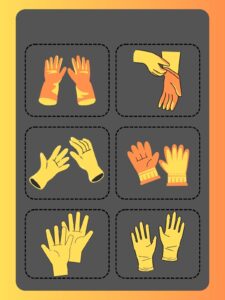Safety gloves
Safety gloves are, therefore, very central in saving a limb in any kind of environment against all odds. This could really make a difference anywhere at work, in a hospital, or just another normal activity. In this guide, learn the importance, the different types, and better practices that you can put into observation in using them to give you optimum protection. The safety gloves are a line of first defense against hazardous risks within working environments.
Whether industrial, laboratory, construction, or even domestic anywhere the possible risk of physical danger creeps in gloves, to mention but a few hand-related injuries would help greatly to reduce most cuts, grazes, and chemical burns. Knowing the various types of protective gloves and their applications is very key to providing maximum protection and a safe working environment.
Why Safety Gloves Are Important?
Workers need Best protective gloves to protect their hands from many risks, such as cuts, burns, chemicals, and grazes. Hands are normally the weak part of the body, especially according to the nature and environment where the tasks or processes are going to be involved. Examples include construction or manufacturing, where the tools and machinery might be in sharp operation, and in healthcare, infection control is a necessity through gloves.
This is how almost all gloves have been crafted. They have the best gripping ability in the fingers, and therefore dexterity to their moment, which might help grab tools and materials safely. Comfort and hygiene: Properly fitting gloves improve comfort and possibly promote hygiene in medical and food-handling contexts.
Best protective gloves
Cut Resistant Gloves
These are gloves to protect against cuts and lacerations. They are usually made from materials like Kevlar, metal mesh, or any other high-performance fibers. Such gloves are worn while one is handling sharp tools, glass, or metal.
On closer observation, the insulating gloves are made up of very high-temperature-resistant materials, usually made of Kevlar, leather, or any other artificial material designed for the purpose. Gloves find their applications in various metallurgical and glass-manufacturing industries, along with those processes involving the welding process, because of regular exposure to high temperatures.
Chemical-resistant gloves
Chemical-resistant gloves are promised to prevent contact with many hazardous chemicals. Normally, they are constructed using materials such as nitrile, neoprene, or latex, which are capable of being in direct contact with chemicals, oils, and other organic solvents. This can be stated as one of the most important tools present in a scientific laboratory, chemical processing plant, or cleaning facility.
Electrical Gloves
The electrical gloves are primarily worn to protect their wearers from electrical shocks. The material used in their preparation comprises an insulating material such as rubber, and the gloves are tested for voltage at desired levels. These gloves have become very essential for electricians and maintenance personnel who work on live electrical circuits.
General Purpose Gloves
General-purpose gloves These gloves offer general protection with comfort for general use. They are usually made from cotton, synthetic fabrics, or leather. Since this type of gloves offers relatively less specialized protection, they are widely employed in general works that are quite hazardous.
Risk Assessment
Clearly define what are the exact risks from activity or are, for example, cuts, heat, chemicals, electrical dangers.
Material Compatibility
Choose the gloves according to the material that can provide the necessary type of protection appropriately. This would mean that, for instance, residual human waste handlers should wear nitrile gloves, while welders should wear leather gloves.
It means that the gloves will create a good, comfortable fit and may be worn any length of time. If the gloves do not fit the person to a T, this will decrease dexterity and raise the possibility of an accident.
Durability
How long do you want the glove to last, given the work environment? Some gloves are designed, strictly speaking, to be used only once and then disposed of. Others are made to be used for a whole day.
Proper Putting On and Taking Off: Wear the gloves in a manner to prevent contamination; put them on in a way that won’t introduce an exposure to the glove. Take them off carefully; skin shall not come into contact with material on the glove surface. Inspection: Visually inspect the gloves for any possible damage or wear. Gloves should be replaced if torn, punctured, or otherwise compromised of integrity.

Positive and Negative assets
Cut and Abrasion Protection:
The gloves protect your hands from sharp objects, rough surfaces, and abrasive materials, hence reducing the chance of cuts, cuts, or any other skin injury.Thus, one of the measures within the realm of possibility to ensure the need for occupational health and safety is the employment of working gloves. This would avoid legal complications and promote a safer workplace.
Chemical Protection:
The specialized gloves are made of nitrile or neoprene to protect against deleterious chemicals, solvents, and acids that cause burns or injury to the skin.Some materials in the gloves, such as latex, tend to trigger allergies in sensitive skin and cause skin irritations or some other health issues.
Limited Protection Ends
Thermal Protection:
High-temperature-resistant gloves protect from burns and lacerations due to contact with hot equipment, flames, or molten material. These are particularly important in the welding and foundry industries.Most working gloves are designed for superior grip and dexterity, hence helping to handle tools and materials more easily with a reduced risk of accidents caused by slipping.
Compliance with Regulations:
Avoidance of Injuries:
Gloves can reduce the impact of injuries if accidents happen to occur, either by the process of shock absorbance or by acting like a barrier to dangerous materials.Ergonomically designed gloves would reduce hand fatigue due to repetitive tasks and improve comfort and productivity.
Reduced Dexterity:
Some safety gloves may cause a loss in manual dexterity and fine motor skills; these, in turn, might inhibit certain tasks that require fine precision
Heat Build-up:
Heat will collect in the gloves over time leading to sweating, which may cause discomfort or make the user feel awkward or even unhygienic.
Cost:
High-quality safety gloves come at a price, especially the ones that involve an add-on of specific features; these increase the overall PPE costs for organizations.
Maintenance and Replacement:Safety gloves need to be regularly inspected for wear and tear and are to be replaced regularly. This procedure will be time-consuming and expensive.There is an additional risk of complacency as far as other safety practices are concerned hence over-reliance on gloves may increase the risks of an accident if hazards are not addressed through other measures.
Protective gloves
Protective or safety gloves form one of the main tools in defending hands against a good number of unsafe situations in short. Proper selection of gloves according to the nature of the work, along with correct advice about their use, will help improve protection against injury and foster a greater attitude toward safety in the surrounding environment. The constant evolution of technology and materials, together with continued monitoring of the safety glove designs, further increases workplace safety and reduces likely risks associated with hand injuries. It would involve more than buying good quality safety gloves it would be a step toward a much safer and more safe work environment.

